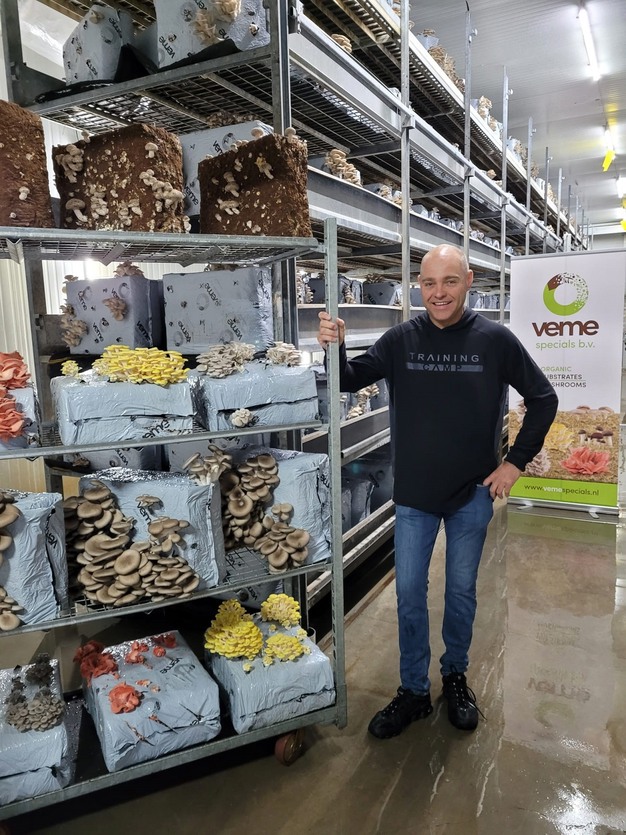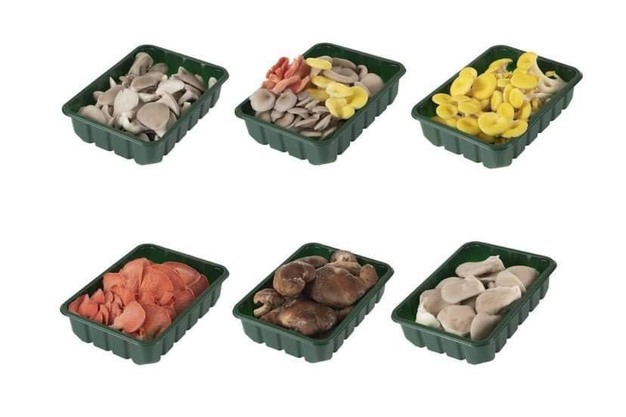"Oyster mushrooms are being increasingly appreciated fresh, and they're more often included in supermarkets' mushroom mixes." That is how John Verbruggen of Verbruggen Paddestoelen - who organically cultivates 15 tons of, among others, oyster mushrooms per week - summarizes the growing mushroom market.
John attributes consumer interest to oyster mushrooms' healthy traits. He points out these thin-fleshed mushrooms, grown under lights, are, for example, far likelier to convert ergosterol, present in mushrooms, into vitamin D than other varieties. "They also contain, for instance, beta-glucans and lovastatin, which are involved in a healthy immune system and cholesterol levels. Oyster mushrooms are super healthy, but because that's not widely known, Europeans underappreciate them," he begins.

Meaty structure
"These mushrooms' structure, similar to meat, adds to their popularity. Oyster mushrooms grow in three weeks, and then you have a meat-like product that contains vitamins and substances people need. Plus, oyster mushrooms taste umami, the fifth flavor. Thus, they make a dish delicious without you having to add salt.” John sees a bright future in using oyster mushrooms as meat substitutes in, say, croquettes, 'bitterballen', and pesto or carpaccio. "Sales reflect that growth and more and more oyster mushrooms are destined for further processing into other products," he says.
Blend product
John has high hopes for their use in so-called blend products, too, where mushrooms replace a proportion of meat. "Hamburger patties that are, say, half oyster mushrooms are much juicier. They’re also lower in calories and contain fiber." That growth is, however, lagging in the organic segment. He says before the pandemic, organic made up about 70% of Verbruggen Mushrooms' sales. Now, that is 30%. "Total sales are increasing substantially, but the organic volume is, unfortunately, not growing enough alongside that," Verbruggen explains.
Hurdles
There are also other hurdles, such as the sharply rising labor costs. "In January 2024, there will be another 10% increase. In neighboring countries, labor costs are rising, too, but not as fast as in the Netherlands.” Added to that are higher energy and transportation costs. That means keeping costs under control has, thus, become an essential focus for Verbruggen Mushrooms.
Those rising costs are one reason why mushroom farming is changing. John sees that while oyster mushroom cultivation is expanding, standard mushroom farms are struggling and finding it harder to keep up with the market. "The Netherlands used to lead in mushroom cultivation; now it's Poland. Their lower costs mean that country's taken over, and, so, there are fewer and fewer Dutch growers," John explains, adding that he expects a mushroom market will undoubtedly remain, though he also anticipates the number of mushroom growers in the Netherlands to keep shrinking.
Exports under pressure
Whereas Poland and the Netherlands export mushrooms, other European countries import them. But, those that do so are decreasing because of the increasing popularity of local food. As a result, mushroom cultivation is increasing in countries like Germany and France. The oyster mushroom grower cites that as a reason exports are becoming harder. "Those local products get priority in supermarkets.”

Exotics cultivation, on the other hand, is still in its infancy, John points out. The Netherlands has an advantage regarding growing exotic mushrooms. "We're a high-tech company, whereas some overseas growers cultivate in old pig pens. They cannot offer the same continuity and quality," he explains. Verbruggen Mushrooms sells some 70% of its mushrooms in the Netherlands and exports the rest.
John sees that many growers go belly up in countries like Spain and Italy, which produce plenty of oyster mushrooms. "Those growers cultivate in tents, so are weather dependant . When it's sunny, there are lots of mushrooms; when the weather's bad, there are none for a while. Supermarkets can't work with that." As a result, oyster mushroom popularity is declining in those countries. "That's because those are always available at the wrong time and quantity," he concludes.
Circular
Verbruggen Paddestoelen considers circular cultivation critical. And that starts with the organic substrate they produce. Together with subsidiary Veme Specials BV, they sell over 400 tons of oyster and shiitake mushroom substrate worldwide every week. Unlike standard mushrooms, oyster and shiitake mushrooms are grown exclusively on vegetable substrate. Some ingredients, such as sunflower and elephant grass, Verbruggen grows. But they use, say, mowed grass from ecological corridors, too.
They try to source materials as locally as possible. The only exception is organic straw that comes from Belgium and France. The materials are crushed, pasteurized, and pressed into blocks. Since recently, those remaining after cultivation - not yet covered by the building code - are being used in a test process in construction. So, when a structure has to be replaced, you can use those natural materials as fertilizer for the land. "We all want less CO2 in the atmosphere, and we're trying to help achieve that as much as possible," says John.
John Verbruggen Verbruggen Paddestoelen BV
Verbruggen Paddestoelen BV
Heesakker 19
5469 AV Erp
Tel.: +31 (0)413 211893
sales@verbruggen-paddestoelen.nl
www.verbruggen-paddestoelen.n l
